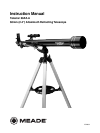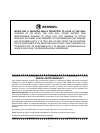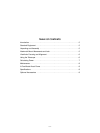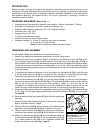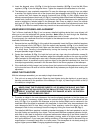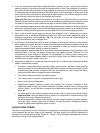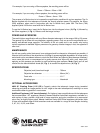
– 7 –
3.
If you are observing an astronomical object (the Moon, a planet, star, etc.) you will notice that the
object will begin to move slowly through the telescopic field of view. This movement is caused by
the rotation of the Earth and makes an object appear to be moving in the telescope’s field of view.
To keep astronomical objects centered in the field, simply move the telescope on one or both of its
axes (vertical and/or horizontal) as appropriate. At higher powers, astronomical objects will seem
to move through the field of view of the eyepiece more rapidly.
Obser
ving Tip:
Place the object to be vie
wed at the edge of the field and, without touching the
telescope, watch it drift through the field to the other side before repositioning the telescope so that
the object to be viewed is again placed at the edge of the field, ready to be further observed.
4. Avoid touching the eyepiece while observing through the telescope. Vibrations resulting from such
contact will cause the image to move. Avoid observing sites where vibrations may introduce image
movement. Viewing from the upper floors of a building may also introduce image movement.
5. Allow a few minutes for your eyes to become “dark adapted” prior to attempting any serious
observations. Use a red-filtered flashlight to protect your night vision when reading star maps, or
inspecting components of the telescope.
Tip: You can make your own red filtered flashlight by
taping red cellophane over a flashlight lens.
6. Avoid setting up the telescope inside a room and observing through an opened or closed window
pane. Images may appear blurred or distorted due to temperature differences between inside and
outside air. Also, it is a good idea to allow your telescope to reach the ambient (surrounding)
outside temperature before starting an observing session.
7. Planets and other objects viewed low on the horizon often lack sharpness—the same object, when
observed higher in the sky, will appear sharper and have greater contrast. Turbulent air in the
atmosphere can cause images to “shimmer” in the eyepiece. Try reducing power (change your
eyepiece) until the image steadies. Keep in mind that a bright, clear, but smaller image is more
interesting than a larger, dimmer, fuzzy one.
8. Astronomical software or a good star atlas will assist you in locating many interesting celestial
objects. These objects include:
• The Moon, covered with craters, mountain ranges, and fault lines. The Moon is best observed
during its crescent or half phase when Sunlight strikes the Moon’s surface at an angle. It casts
shadows and adds a sense of depth to the view. No shadows are seen during a full Moon,
causing the bright Moon to appear flat and uninteresting.
• Cloud belts across the surface of the planet Jupiter.
• The 4 major moons of J
upiter, changing position each night.
• Saturn and its famous ring system.
• Deep-Space: Nebulae, galaxies, multiple star systems, star clusters—hundreds of such
objects are visible through your Telestar telescope. If possible, observe under a dark sky, away
from city lights—y
ou will be ab
le to observe more deep-space objects through your Telestar
telescope.
• Terrestrial objects: Your Telestar telescope may also be used for high-resolution land viewing.
Important Note: Using the diagonal mirror results in an image which is reversed left-for-right,
b
ut which is correctly or
iented up-and-do
wn.
T
errestr
ial observations should almost always be made using the 25mm low-power eyepiece
for bright, sharp images. Observing horizontally through the Earth's atmosphere distorts
images in higher-power eyepieces (such as 9mm).
CALCULATING POWER
The power (magnification) at which a telescope is operating is calculated by dividing the focal length
of the telescope by the focal length of the eyepiece. The focal length of the 60-AZ-A telescope is
identified on the focuser label as being 700mm (F = 700mm).The focal length of the eyepiece is usually
identified on the top of the eyepiece barrel.



